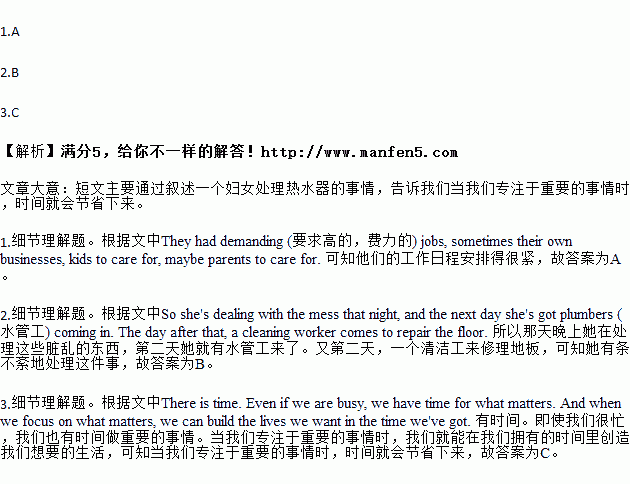题目内容
We'll save bits of time here and there, add it up, and we will finally get to everything we want to do. But after studying how successful people spend their time and looking at their schedules (时刻表), I think this idea has it completely backward. We don't build the lives we want by saving time. We build the lives we want, and then time saves itself.
I recently did a time diary project looking at 1,001 days in the lives of unusually busy women. They had demanding (要求高的,费力的) jobs, sometimes their own businesses, kids to care for, maybe parents to care for.
One of the women whose time log I studied goes out on a Wednesday night. She comes home to find that her water heater has broken, and there is now water all over her rooms. If you've ever had anything like this happen to you, you know how frightening it is. So she's dealing with the mess that night, and the next day she's got plumbers (水管工) coming in. The day after that, a cleaning worker comes to repair the floor. It takes seven hours of her week. Seven hours. That's like finding an extra hour in the day.
But I'm sure if you had asked her at the start of the week, "Could you find seven hours to go to the gym?" I'm sure she would've said, "No! Can't you see how busy I am?" Yet when she had to find seven hours because there is water all over her rooms, she found seven hours. And what this shows us is that time is highly changeable. We cannot make more time, but time will reach for what we choose to put into it.
Small moments can have great power. You can use your bits of time for bits of joy. Maybe it's choosing to read something wonderful on the bus on the way to work. I know when I had a job that required two bus rides every morning, I used to go to the library on weekends to get books to read. It made the whole experience almost enjoyable.
It's about looking at the whole of one's time and seeing where important things can go. I truly believe this. There is time. Even if we are busy, we have time for what matters. And when we focus on what matters, we can build the lives we want in the time we've got.
1.What do we know about the women in the speaker's project?
A.They had a busy work schedule. B.They were single business women.
C.They followed their schedule strictly. D.They had to look after both their kids and parents.
2.What does the woman do when she finds her home a mess?
A.She is too worried to do anything. B.She deals with it in an orderly way.
C.She fixes the broken water heater by herself. D.She spends seven hours thinking of what to do next.
3.What can we learn from the passage?
A.It is important to set and achieve life goals. B.The key to success is to make full use of time.
C.Time saves itself when we focus on what matters. D.It's unwise to make your work schedule too busy.


